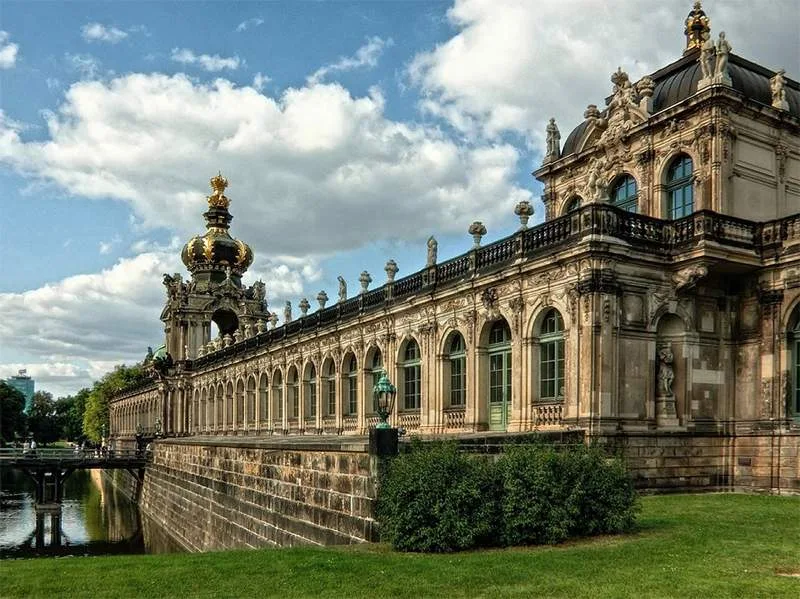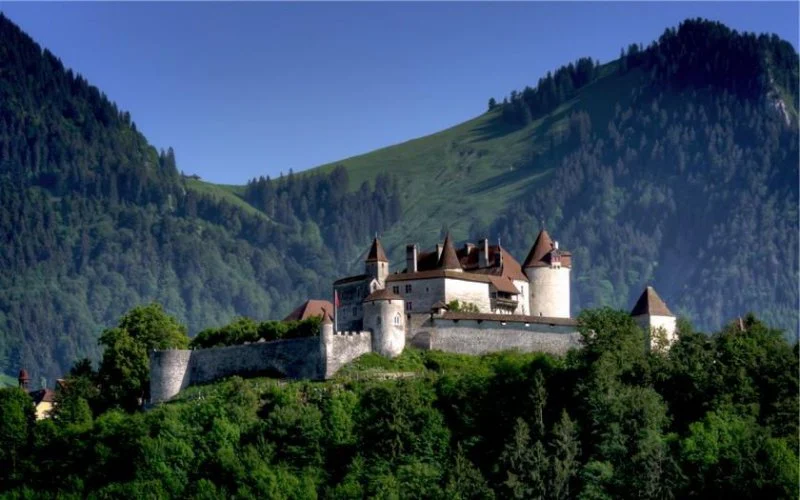1. Victoria Memorial in Kolkata (India)
The Victoria Memorial, built in Kolkata in honor of the British Queen and Empress of India at the same time, is rightfully called one of the most outstanding buildings in India.
A huge, perfectly proportioned building of snow-white marble, with elements of the American Capitol and the Indian Taj Mahal, surrounded by magnificent gardens. This masterpiece of architectural thought, illuminated by the rays of the setting sun and reflected in the water surface of the ponds, is an integral part of Kolkata's favorite tourist destination. The interior of the memorial also deserves attention. Currently, there is a museum, which displays exhibits reflecting the history of the city, and rare books. The memorial was designed by William Emerson in the Indo-Saracen style with elements of oriental eclecticism. The first stone was laid in 1906.The very idea of the building and the palace complex was to glorify the power of the British Empire.
 |
| Victoria Memorial in Kolkata |
2. Changdeokgung Palace Complex (South Korea)
The Changdeokgung Palace Complex ("Palace of Prosperous Virtue") was built by order of Emperor Taejon. A picturesque corner was chosen for him and a special "Bureau for the construction of the palace" was formed. Construction was carried out from 1405 to 1412. During this time, a whole complex of palaces appeared on the territory of 58 hectares, which perfectly fit into the rugged terrain. Changdeokgung was completely destroyed twice: the first time by the Japanese invasion, the second time by fire. The current objects are mainly reconstructions of the 19th – 20th centuries.
Changdeokgung consisted of many formal and residential buildings surrounded by a beautiful park. The new palace complex was the center of power in Korea from 1618 to 1896. Members of the royal court and government lived here until the Gyeongbokgung Palace was recreated. The last Korean emperor lived in Changdeokgun.
 |
| Changdeokgung Palace Complex |
3. Fushimi Castle (Japan)
Fushimi Castle, or Momoyama Palace, is an ancient castle located in the former capital of Japan, Kyoto. It was built in 1592-1594. on Mount Shigetsu. Fushimi served as the summer residence of Toyotomi Hideyoshi, a prominent military leader and statesman. In 1596 a strong earthquake struck Japan. The structure was completely destroyed and recreated on Mount Kihata.
The castle, one of the greatest attractions of the time, had a golden tea room and rooms for theatrical performances. After Hideyoshi's death, the commander Tokugawa Ieyasu used Fushimi as a stronghold for a long time, and then in 1652 gave the order to demolish it. Some parts were moved to Nijo Castle and Daitokuji Monastery. Only in 1964 did the government begin reconstruction of the building, in particular its main tower. There is a small beautiful garden around the castle, where you can admire the early varieties of sakura, snow willow, magnolia.
 |
| Fushimi Castle |
4. Imperial Summer Palace of Mountain Resort (China)
The summer estate of the Chinese emperors of the Qing dynasty in Hebei province was built between 1703 and 1792. in a beautiful valley among the majestic mountains. The magnificent park ensemble is surrounded by a 10-kilometer wall and is divided into four parts - palace, lake, plain and mountain. The palaces and temples of the complex erected in various styles are devoid of pomp. They are graceful and graceful.
The magnificent temples located outside the imperial summer resort also belong to a single architectural ensemble. Some of them are modeled after traditional Tibetan Buddhist monasteries. The structures that have survived to this day date back to 1713–1780. The imperial resort and temple complexes are considered rare historical sites that demonstrate the latest stage in the development of feudal society in China. Currently, there is a museum in the palace-residence, open to the public.
 |
| Imperial Summer Palace of Mountain Resort |
5. Zwinger Palace (Germany)
Museums, churches and palaces in Germany are real magic boxes filled with works of art from all over the world. The country's architectural treasures range from well-preserved Roman ruins to the latest in modern construction. Dresden, known in Germany as Florence on the Elbe, has survived the devastating bombing of World War II and floods, but never ceases to amaze tourists with its splendor. Among the main attractions of Dresden, a special place is occupied by the Baroque Zwinger Palace - the visiting card of the city.
The palace houses the richest collection of cultural and architectural treasures. These are paintings by Dutch, Italian and Spanish masters, including the famous "Sistine Madonna" by Raphael, a collection of porcelain, sculpture and weapons. If you love art, architecture and history, then this place is just for you.
 |
| Zwinger Palace |
6. Luxembourg Palace (France)
The magnificent palace and park complex near the Saint-Sulpice Church is one of the pearls of the French capital. The Luxembourg Palace was built in a sophisticated late Renaissance style with early Baroque elements. It was erected on the initiative of Queen Maria de Medici, mother of the future heir to the throne, Louis XIII, and was conceived as a copy of the Pitti palace in her native Florence. To develop a suitable copy project, French artists were sent to Italy. The interiors of the palace, among other things, were decorated with collections of paintings by various artists, the themes and plots of which Maria de Medici herself determined when ordering. Unfortunately, due to multiple changes of owners almost nothing has survived from the original interior design of the palace: cycles of paintings are scattered across museums and private collections. However, these losses are offset by other assets, such as the work of Delacroix.
Back in the 18th century. the palace became a museum - the prototype of the Louvre. Nowadays, the Senate of the Republic is located here, but the palace park remains available for free visits.
 |
| Luxembourg Palace |
7. Wallenstein Palace (Czech Republic)
Wallenstein Palace, located at the foot of the hill, is one of the largest structures of its kind in Prague and one of the first Czech baroque palaces. Outside, the building is richly decorated with stucco molding, inside with mirrors, drawings and copies of Italian carpet wallpaper. The lavishly decorated Knights' Hall deserves special attention. The castle garden is also interesting, with numerous graceful sculptures by Adrian de Vries. The imperial nobleman Albrecht Wallenstein, an extremely ambitious man, conceived to build a palace that would surpass the royal city in splendor and luxury of decoration. Designed to demonstrate wealth and power, the palace is decorated with frescoes by the famous Baccio del Bianco, which depict the owner in the form of the god of war.
 |
| Wallenstein Palace |
8. Hungarian Parliament Building (Hungary)
The stunning palace of the Hungarian Parliament Building is located on the banks of the Danube. This monumental building is still the largest in Hungary. Its scale cannot fail to impress: the palace stretches 268 m in length, 123 m in width, and the height of the spire of the main dome reaches 90 m! The building is decorated with 90 statues outside and 152 inside. The palace includes almost 700 rooms, the interior decoration of which was used for about 40 kg of gold. The project belonged to the outstanding architect Imre Steindl, who preferred the neo-Gothic style. Looking at this incredible scale, it begs an analogy with the famous Palace of Westminster. The idea of creating this architectural colossus dates back to 1873, when two cities - Buda and Pest - became one and gave rise to the new future capital of Hungary. It was assumed that the plan could be realized by 1896, the millennium of Hungarian statehood, but construction was carried out until the first years of the new century.
 |
| Hungarian Parliament Building |
9. Gruyères Castle (Switzerland)
Gruyères Castle is located in a beautifully preserved medieval town of the eponymous canton Friborg. The first information about the castle building dates back to 1073, although scientists believe that the main part of the building belongs to the XII-XIII centuries. The oldest architectural elements are the square tower and the belt of the inner wall of the enclosure that delimits the castle courtyard from the west, north and east. Gruyères reached its greatest prosperity in the 16th century. - lost the appearance of a medieval fortress and turned into a comfortable residential residence. For two centuries, up to 1798, it played a purely administrative role and did not participate in military conflicts, which is why its buildings are so well preserved. In the XVI-XVIII centuries. Gruyères Castle was enriched with new interiors in the Baroque style.
Probably, at the same time, a French garden appeared on the eastern side of the terrace. In the middle of the XIX century. the castle was acquired by an industrialist from Geneva, Jean-François Beauvy, who used it as a summer residence. In 1938, the cantonal government of Friborg took over the maintenance of the castle and opened a museum.
 |
| Gruyères Castle |
10. Palace of Zarzuela (Spain)
On one of the hills on the banks of the Manzanares River in Madrid, there is a majestic and austere palace of the Spanish kings. A luxurious park and magnificent alleys pleasing to the eye form an ideal ensemble with the building, despite the fact that they were created a little later. King Philip V, the grandson of Louis XIV, who represented the Bourbon dynasty on the Spanish throne, wanted to build a residence that would not be inferior to the Verasal palace of his great grandfather. This idea was not new among European monarchs. On the advice of his wife, the king invited Italian designers who, for 26 years, had been building a baroque palace that could rival Versailles in beauty. The interior of the building in the Rococo style and the exhibits surpass all expectations of visitors in their grandeur.
 |
| Palace of Zarzuela |
